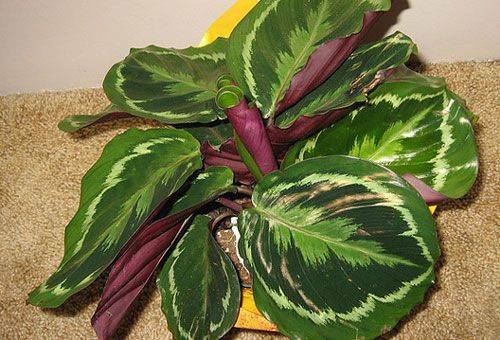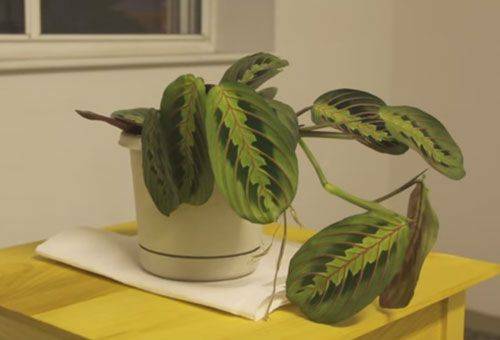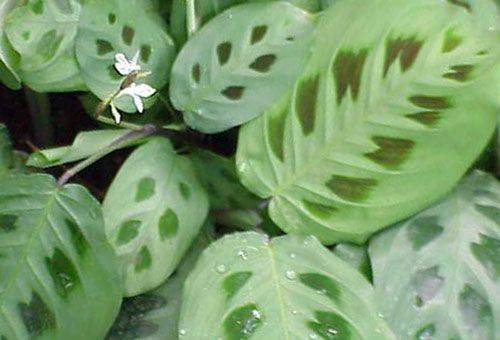Contents:
- Optimal conditions for the cultivation of the arrowroot
- Rules for the transplantation of the prayer plant
- Common problems in the cultivation of the arrowroot and methods of combating them
Amateurs of indoor green plantations should take a closer look at the marantha, a perennial herbaceous plant native to Brazil, able year after year to please the owners of the bright decorativeattractiveness. Caring for the arrowroot at home is not easy, but with careful consideration the flower will not cause big problems. Its distinctive feature is a specific reaction to unfavorable trace conditions.

If you follow the pattern according to all rules, then its leaves will be in a strictly horizontal position. The green pet reacts to the influence of negative factors by moving the leaves to a vertical position. For this property in people, the arrowroot is called the "prayer plant".
Optimum conditions for the breeding of the arrowroot
The flower species are few, there are no more than two and a half dozen. They all have roots in the form of tubers and medium sizes. Variety is observed only in the form of leaves and the type of shoots. The first can be round, oblong and in the form of an ellipse. The second stand straight or creeper. Regardless of the variety, care for the arrowroot begins with the creation of ideal environmental conditions.

- Accommodation. The flower prefers loneliness and reacts negatively to a close neighborhood( irrespective of whether these are the species of the arrowroot or representatives of other families).It is necessary to exclude the possibility of drafts and temperature changes. The bush should not be placed on the windowsill, it will be more comfortable in the back of the room. Light is welcome scattered, not direct, not plentiful.
- Optimal temperature. In the winter period, the optimal values are 15-17ºС, in summer - 22-24ºС.A sharp decrease in temperature with an equally sharp subsequent increase often leads to the death of the plant. If there is such a possibility, it is better to maintain the temperature around 18 ° C year round.
- Watering. Must be frequent and abundant. All kinds of arrowroot respond positively to excess moisture. The main thing is not to fill the flower until the roots rot. Ideally, the earthen should be kept in a stable wet state with no traces of fluid stagnation. In winter, the amount and quality of irrigation can be slightly reduced, but only if the temperature is lowered. Water for irrigation must be pre-protected and warmed to room temperature.
Tip: In order not to flood the arrowroot, watering should be done frequently, and portions are small. An additional advantage will be the layout of sphagnum or wet peat on a pallet.

- Humidity of air. A moody flower will appreciate the increased humidity. To achieve optimal performance, it is recommended to use a special humidifier or at least regularly spray the plant.
- Soil characteristics. The substrate is better to choose a light, breathable. Experienced plant growers can mix the composition themselves, beginners better use finished products.
- Features of introducing top dressing. Caring for the arrowroot without introducing additional food will not give the desired result. In the summer, the frequency of fertilizer application should be several times a couple of weeks. In the cold months, this indicator can be reduced to times of a month and a half. Preparations are better to take complex, presupposing preliminary dilution.
The creation of such conditions will allow maintaining the flower in the optimal state for several years. True, only with the condition of its timely and correct transplantation, as well as elimination of factors provoking the development of common problems.
Rules for transferring the prayer plant
The first transplant is carried out immediately after the acquisition of the plant, provided that it was contained in a plastic pot, in the transport soil. After that, the manipulation is performed no more often than once in two years, choosing at the same time the capacity, the diameter of a couple of centimeters superior to the previous one.

The procedure itself is quite simple and looks like this:
- At the bottom of the new pot we spread the drainage layer, sprinkle it with a part of the nutrient soil.
- Next we prepare the plant for transplantation. To do this, first we cultivate its outer part: we cut off the dried leaves, we wipe the elements from dust.
- We extract the flower from the old pot, carefully remove the clods of the old earth( if this is a planned transplantation of an adult plant, then the soil can not be disposed of).
- Copy the copy to a new location, sprinkled with its soil, which is only slightly tamped.
Before transplanting, you should carefully read the soil composition. If there is lime in it, it is better to refuse the product. This component significantly slows the growth and development of the arrowroot.
Common problems in the cultivation of the arrowhead and methods of controlling them
Improper care of the flower can lead to the development of the following undesirable phenomena:
- Wilting and subsequent death of stems are a sign of too low temperature and high humidity.
- Yellow, crumbling leaves opposite indicate excessive dryness of the air. Before proceeding with the correction of the conditions, it is necessary to make sure that the plant does not suffer from too much watering. This too can cause a similar reaction.
- Twisted leaves are consequences of too bright and abundant illumination. If in time it is detected and rearrange the arrowrock in the shadow, then the elements quickly return to normal.
- If the leaves are not only folded into tubes, but also covered with specific spots, this indicates a lack of moisture. Watering should be increased, but it is not necessary to increase the volume of single portions.

To the great regret of lovers of a bright green bush, it is often subjected to pest attacks. Most often as a parasite acts as a shield or a red spider mite. In the first case, faintly discernible brownish plaques form on the leaves and stems. If you do not tackle the treatment, then the parasite will destroy the plant, sucking the juice out of it. At the initial stage, the soap solution will cope with the infection. Moisten the sponge in it and wipe the affected areas.
The pale color of the leaves and the appearance of whitish spots are signs of the mite's vital activity. It is necessary to start immediately the use of Actellik, Derris or Phytoverma to prevent the loss of leaves. In extreme cases, you have to cut off the affected elements, but you need to do it carefully and with special tools. Moreover, the treatment with medicinal products does not cancel this.
Marantha can become a real highlight of a boring decor, but only if it maintains its health and decorative appeal.
We recommend reading the article: How to care for croton
